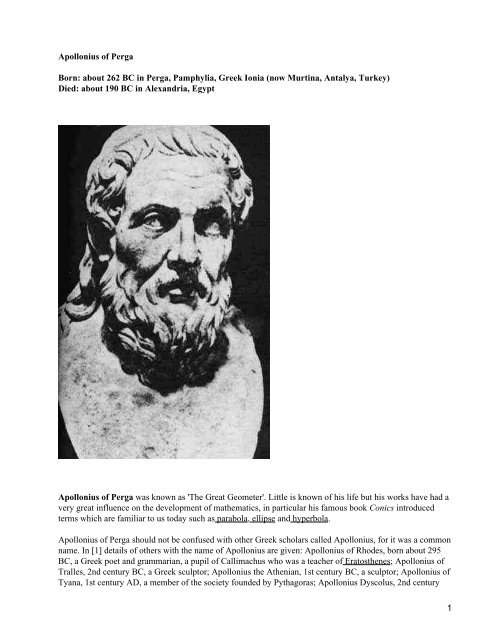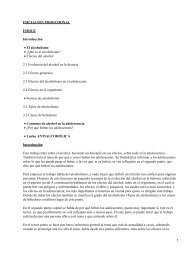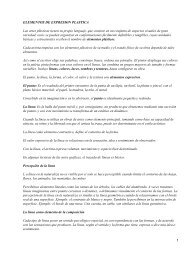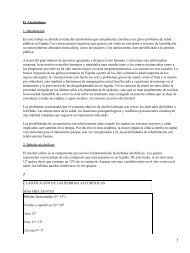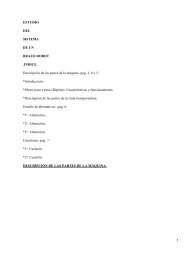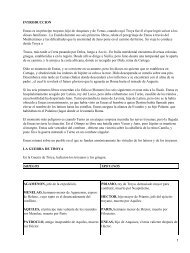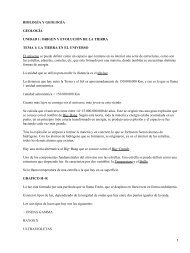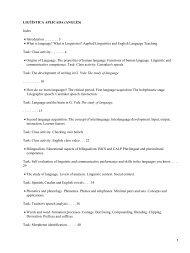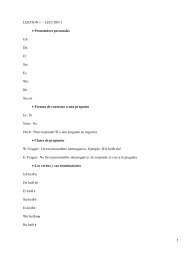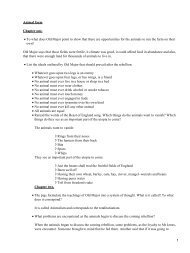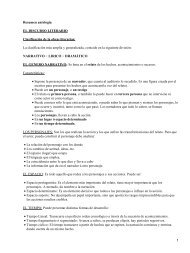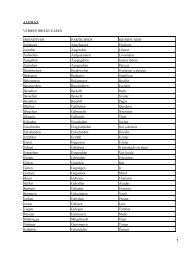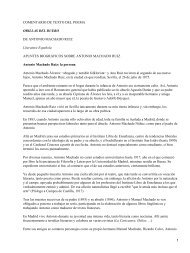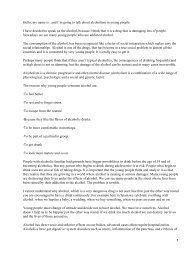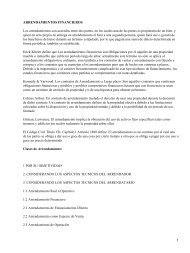Apollonius of Perga Born: about 262 BC in Perga, Pamphylia, Greek ...
Apollonius of Perga Born: about 262 BC in Perga, Pamphylia, Greek ...
Apollonius of Perga Born: about 262 BC in Perga, Pamphylia, Greek ...
Create successful ePaper yourself
Turn your PDF publications into a flip-book with our unique Google optimized e-Paper software.
<strong>Apollonius</strong> <strong>of</strong> <strong>Perga</strong><strong>Born</strong>: <strong>about</strong> <strong>262</strong> <strong>BC</strong> <strong>in</strong> <strong>Perga</strong>, <strong>Pamphylia</strong>, <strong>Greek</strong> Ionia (now Murt<strong>in</strong>a, Antalya, Turkey)Died: <strong>about</strong> 190 <strong>BC</strong> <strong>in</strong> Alexandria, Egypt<strong>Apollonius</strong> <strong>of</strong> <strong>Perga</strong> was known as 'The Great Geometer'. Little is known <strong>of</strong> his life but his works have had avery great <strong>in</strong>fluence on the development <strong>of</strong> mathematics, <strong>in</strong> particular his famous book Conics <strong>in</strong>troducedterms which are familiar to us today such as parabola, ellipse and hyperbola.<strong>Apollonius</strong> <strong>of</strong> <strong>Perga</strong> should not be confused with other <strong>Greek</strong> scholars called <strong>Apollonius</strong>, for it was a commonname. In [1] details <strong>of</strong> others with the name <strong>of</strong> <strong>Apollonius</strong> are given: <strong>Apollonius</strong> <strong>of</strong> Rhodes, born <strong>about</strong> 295<strong>BC</strong>, a <strong>Greek</strong> poet and grammarian, a pupil <strong>of</strong> Callimachus who was a teacher <strong>of</strong> Eratosthenes; <strong>Apollonius</strong> <strong>of</strong>Tralles, 2nd century <strong>BC</strong>, a <strong>Greek</strong> sculptor; <strong>Apollonius</strong> the Athenian, 1st century <strong>BC</strong>, a sculptor; <strong>Apollonius</strong> <strong>of</strong>Tyana, 1st century AD, a member <strong>of</strong> the society founded by Pythagoras; <strong>Apollonius</strong> Dyscolus, 2nd century1
AD, a <strong>Greek</strong> grammarian who was reputedly the founder <strong>of</strong> the systematic study <strong>of</strong> grammar; and <strong>Apollonius</strong><strong>of</strong> Tyre who is a literary character.The mathematician <strong>Apollonius</strong> was born <strong>in</strong> <strong>Perga</strong>, <strong>Pamphylia</strong> which today is known as Murt<strong>in</strong>a, or Murtanaand is now <strong>in</strong> Antalya, Turkey. <strong>Perga</strong> was a centre <strong>of</strong> culture at this time and it was the place <strong>of</strong> worship <strong>of</strong>Queen Artemis, a nature goddess. When he was a young man <strong>Apollonius</strong> went to Alexandria where he studiedunder the followers <strong>of</strong> Euclid and later he taught there. <strong>Apollonius</strong> visited <strong>Perga</strong>mum where a university andlibrary similar to Alexandria had been built. <strong>Perga</strong>mum, today the town <strong>of</strong> Bergama <strong>in</strong> the prov<strong>in</strong>ce <strong>of</strong> Izmir<strong>in</strong> Turkey, was an ancient <strong>Greek</strong> city <strong>in</strong> Mysia. It was situated 25 km from the Aegean Sea on a hill on thenorthern side <strong>of</strong> the wide valley <strong>of</strong> the Caicus River (called the Bakir river today).While <strong>Apollonius</strong> was at <strong>Perga</strong>mum he met Eudemus <strong>of</strong> <strong>Perga</strong>mum (not to be confused with Eudemus <strong>of</strong>Rhodes who wrote the History <strong>of</strong> Geometry) and also Attalus, who many th<strong>in</strong>k must be K<strong>in</strong>g Attalus I <strong>of</strong><strong>Perga</strong>mum. In the preface to the second edition <strong>of</strong> Conics <strong>Apollonius</strong> addressed Eudemus (see [4] or [5])If you are <strong>in</strong> good health and th<strong>in</strong>gs are <strong>in</strong> other respects as you wish, it is well; with me too th<strong>in</strong>gs aremoderately well. Dur<strong>in</strong>g the time I spent with you at <strong>Perga</strong>mum I observed your eagerness to becomeaquat<strong>in</strong>ted with my work <strong>in</strong> conics.The only other pieces <strong>of</strong> <strong>in</strong>formation <strong>about</strong> <strong>Apollonius</strong>'s life is to be found <strong>in</strong> the prefaces <strong>of</strong> various books <strong>of</strong>Conics. We learn that he had a son, also called <strong>Apollonius</strong>, and <strong>in</strong> fact his son took the second edition <strong>of</strong> booktwo <strong>of</strong> Conics from Alexandria to Eudemus <strong>in</strong> <strong>Perga</strong>mum. We also learn from the preface to this book that<strong>Apollonius</strong> <strong>in</strong>troduced the geometer Philonides to Eudemus while they were at Ephesus.We are <strong>in</strong> a somewhat better state <strong>of</strong> knowledge concern<strong>in</strong>g the books which <strong>Apollonius</strong> wrote. Conics waswritten <strong>in</strong> eight books but only the first four have survived <strong>in</strong> <strong>Greek</strong>. In Arabic, however, the first seven <strong>of</strong> theeight books <strong>of</strong> Conics survive.First we should note that conic sections to <strong>Apollonius</strong> are by def<strong>in</strong>ition the curves formed when a plane<strong>in</strong>tersects the surface <strong>of</strong> a cone. <strong>Apollonius</strong> expla<strong>in</strong>s <strong>in</strong> his preface how he came to write his famous workConics (see [4] or [5])... I undertook the <strong>in</strong>vestigation <strong>of</strong> this subject at the request <strong>of</strong> Naucrates the geometer, at the time when hecame to Alexandria and stayed with me, and, when I had worked it out <strong>in</strong> eight books, I gave them to him atonce, too hurriedly, because he was on the po<strong>in</strong>t <strong>of</strong> sail<strong>in</strong>g; they had therefore not been thoroughly revised,<strong>in</strong>deed I had put down everyth<strong>in</strong>g just as it occurred to me, postpon<strong>in</strong>g revision until the end.Books 1 and 2 <strong>of</strong> the Conics began to circulate <strong>in</strong> the form <strong>of</strong> their first draft, <strong>in</strong> fact there is some evidencethat certa<strong>in</strong> translations which have come down to us have come from these first drafts. <strong>Apollonius</strong> writes (see[4] or [5])... it happened that some persons also, among those who I have met, have got the first and second booksbefore they were corrected....Conics consisted <strong>of</strong> 8 books. Books one to four form an elementary <strong>in</strong>troduction to the basic properties <strong>of</strong>conics. Most <strong>of</strong> the results <strong>in</strong> these books were known to Euclid, Aristaeus and others but some are, <strong>in</strong><strong>Apollonius</strong>'s own words:−... worked out more fully and generally than <strong>in</strong> the writ<strong>in</strong>gs <strong>of</strong> others.In book one the relations satisfied by the diameters and tangents <strong>of</strong> conics are studied while <strong>in</strong> book two<strong>Apollonius</strong> <strong>in</strong>vestigates how hyperbolas are related to their asymptotes, and he also studies how to draw2
tangents to given conics. There are, however, new results <strong>in</strong> these books <strong>in</strong> particular <strong>in</strong> book three.<strong>Apollonius</strong> writes <strong>of</strong> book three (see [4] or [5])... the most and prettiest <strong>of</strong> these theorems are new, and it was their discovery which made me aware thatEuclid did not work out the syntheses <strong>of</strong> the locus with respect to three and four l<strong>in</strong>es, but only a chanceportion <strong>of</strong> it, and that not successfully; for it was not possible for the said synthesis to be completed withoutthe aid <strong>of</strong> the additional theorems discovered by me.Books five to seven are highly orig<strong>in</strong>al. In these <strong>Apollonius</strong> discusses normals to conics and shows how manycan be drawn from a po<strong>in</strong>t. He gives propositions determ<strong>in</strong><strong>in</strong>g the centre <strong>of</strong> curvature which lead immediatelyto the Cartesian equation <strong>of</strong> the evolute. Heath writes that book five [5]... is the most remarkable <strong>of</strong> the extant Books. It deals with normals to conics regarded as maximum andm<strong>in</strong>imum straight l<strong>in</strong>es drawn from particular po<strong>in</strong>ts to the curve. Included <strong>in</strong> it are a series <strong>of</strong> propositionswhich, though worked out by the purest geometrical methods, actually lead immediately to the determ<strong>in</strong>ation<strong>of</strong> the evolute <strong>of</strong> each <strong>of</strong> the three conics; that is to say, the Cartesian equations <strong>of</strong> the evolutes can be easilydeduced from the results obta<strong>in</strong>ed by <strong>Apollonius</strong>. There can be no doubt that the Book is almost whollyorig<strong>in</strong>al, and it is a veritable geometrical tour de force.The beauty <strong>of</strong> <strong>Apollonius</strong>'s Conics can readily be seen by read<strong>in</strong>g the propositions as given by Heath, see [4]or [5]. However, Heath expla<strong>in</strong>s <strong>in</strong> [5] how difficult the orig<strong>in</strong>al text is to read:−... the treatise is a great classic which deserves to be more known than it is. What militates aga<strong>in</strong>st its be<strong>in</strong>gread <strong>in</strong> its orig<strong>in</strong>al form is the great extent <strong>of</strong> the exposition (it conta<strong>in</strong>s 387 separate propositions), duepartly to the <strong>Greek</strong> habit <strong>of</strong> prov<strong>in</strong>g particular cases <strong>of</strong> a general proposition separately from the propositionitself, but more to the cumbersomeness <strong>of</strong> the enunciations <strong>of</strong> complicated propositions <strong>in</strong> general terms(without the help <strong>of</strong> letters to denote particular po<strong>in</strong>ts) and to the elaborateness <strong>of</strong> the Euclidean form, towhich <strong>Apollonius</strong> adheres throughout.Pappus gives some <strong>in</strong>dications <strong>of</strong> the contents <strong>of</strong> six other works by <strong>Apollonius</strong>. These are Cutt<strong>in</strong>g <strong>of</strong> a ratio(<strong>in</strong> two books), Cutt<strong>in</strong>g an area (<strong>in</strong> two books), On determ<strong>in</strong>ate section (<strong>in</strong> two books), Tangencies (<strong>in</strong> twobooks), Plane loci (<strong>in</strong> two books), and On verg<strong>in</strong>g constructions (<strong>in</strong> two books). Cutt<strong>in</strong>g <strong>of</strong> a ratio survives <strong>in</strong>Arabic and we are told by the 10th century bibliographer Ibn al−Nadim that three other works were translated<strong>in</strong>to Arabic but none <strong>of</strong> these survives.To illustrate how far <strong>Apollonius</strong> had taken geometric constructions beyond that <strong>of</strong> Euclid's Elements weconsider results which are known to have been conta<strong>in</strong>ed <strong>in</strong> Tangencies. In the Elements Book III Euclidshows how to draw a circle through three given po<strong>in</strong>ts. He also shows how to draw a tangent to three givenl<strong>in</strong>es. In Tangencies <strong>Apollonius</strong> shows how to construct the circle which is tangent to three given circles.More generally he shows how to construct the circle which is tangent to any three objects, where the objectsare po<strong>in</strong>ts or l<strong>in</strong>es or circles.In [11] Hogendijk reports that two works <strong>of</strong> <strong>Apollonius</strong>, not previously thought to have been translated <strong>in</strong>toArabic, were <strong>in</strong> fact known to Muslim geometers <strong>of</strong> the 10th century. These are the works Plane loci and Onverg<strong>in</strong>g constructions. In [11] some results from these works which were not previously known to have beenproved by <strong>Apollonius</strong> are described.From other sources there are references to still further books by <strong>Apollonius</strong>, none <strong>of</strong> which have survived.Hypsicles refers to a work by <strong>Apollonius</strong> compar<strong>in</strong>g a dodecahedron and an icosahedron <strong>in</strong>scribed <strong>in</strong> the samesphere, which like Conics appeared <strong>in</strong> two editions. Mar<strong>in</strong>us, writ<strong>in</strong>g a commentary on Euclid's Data, refersto a general work by <strong>Apollonius</strong> <strong>in</strong> which the foundations <strong>of</strong> mathematics such as the mean<strong>in</strong>g <strong>of</strong> axioms anddef<strong>in</strong>itions are discussed. <strong>Apollonius</strong> also wrote a work on the cyl<strong>in</strong>drical helix and another on irrational3
numbers which is mentioned by Proclus. Eutocius refers to a book Quick delivery by <strong>Apollonius</strong> <strong>in</strong> which heobta<strong>in</strong>ed an approximation forbetter than the223/71


